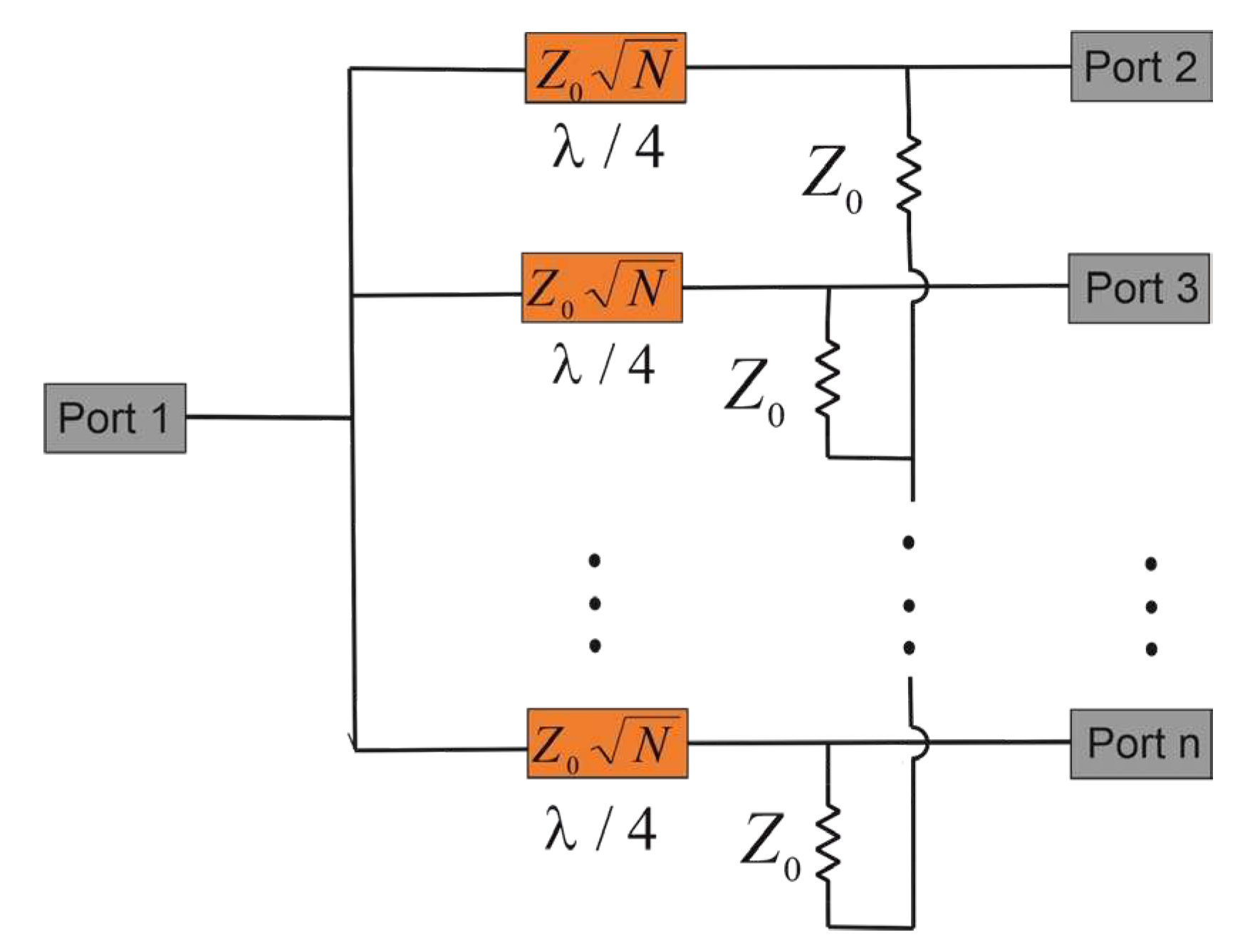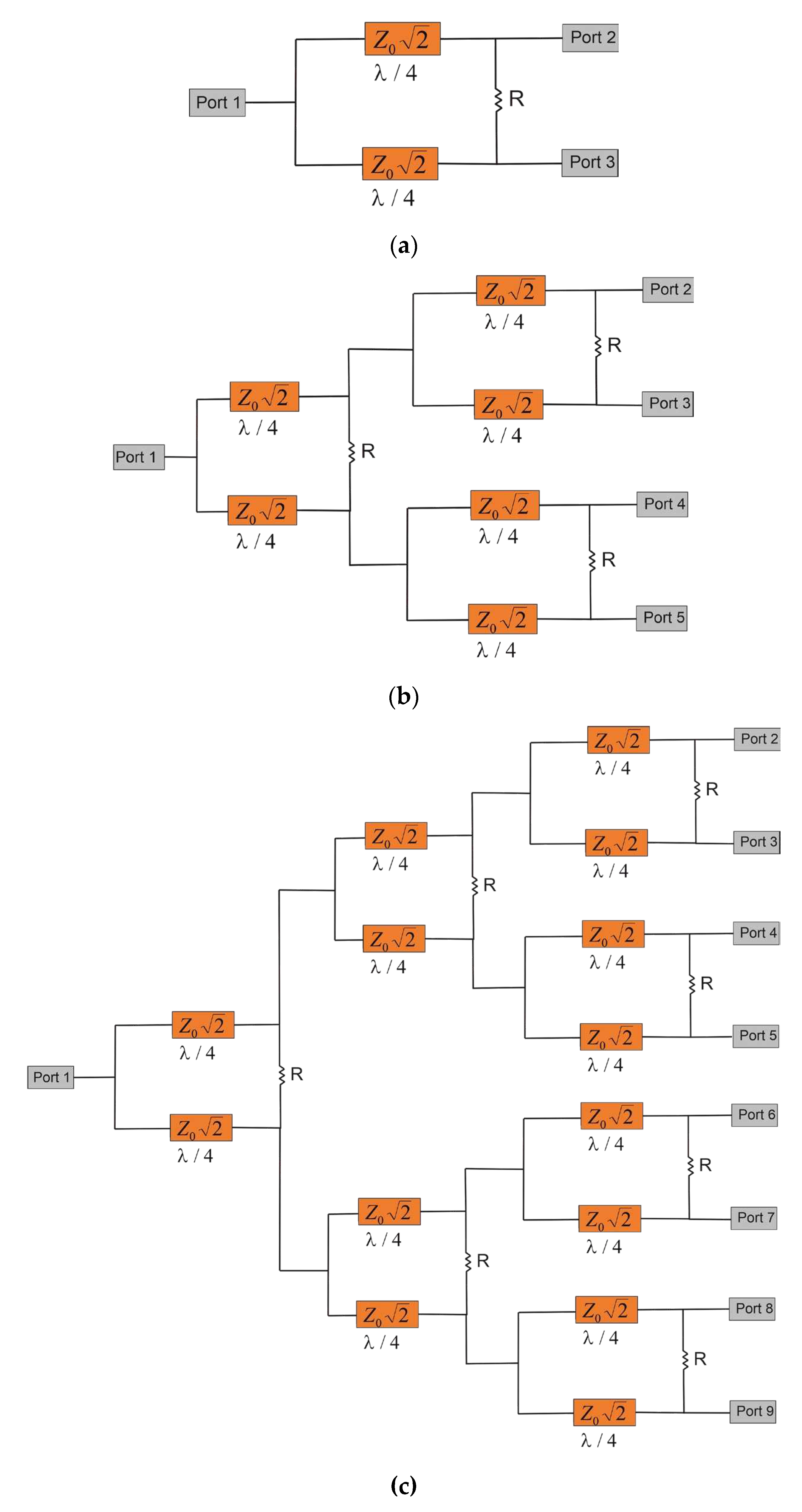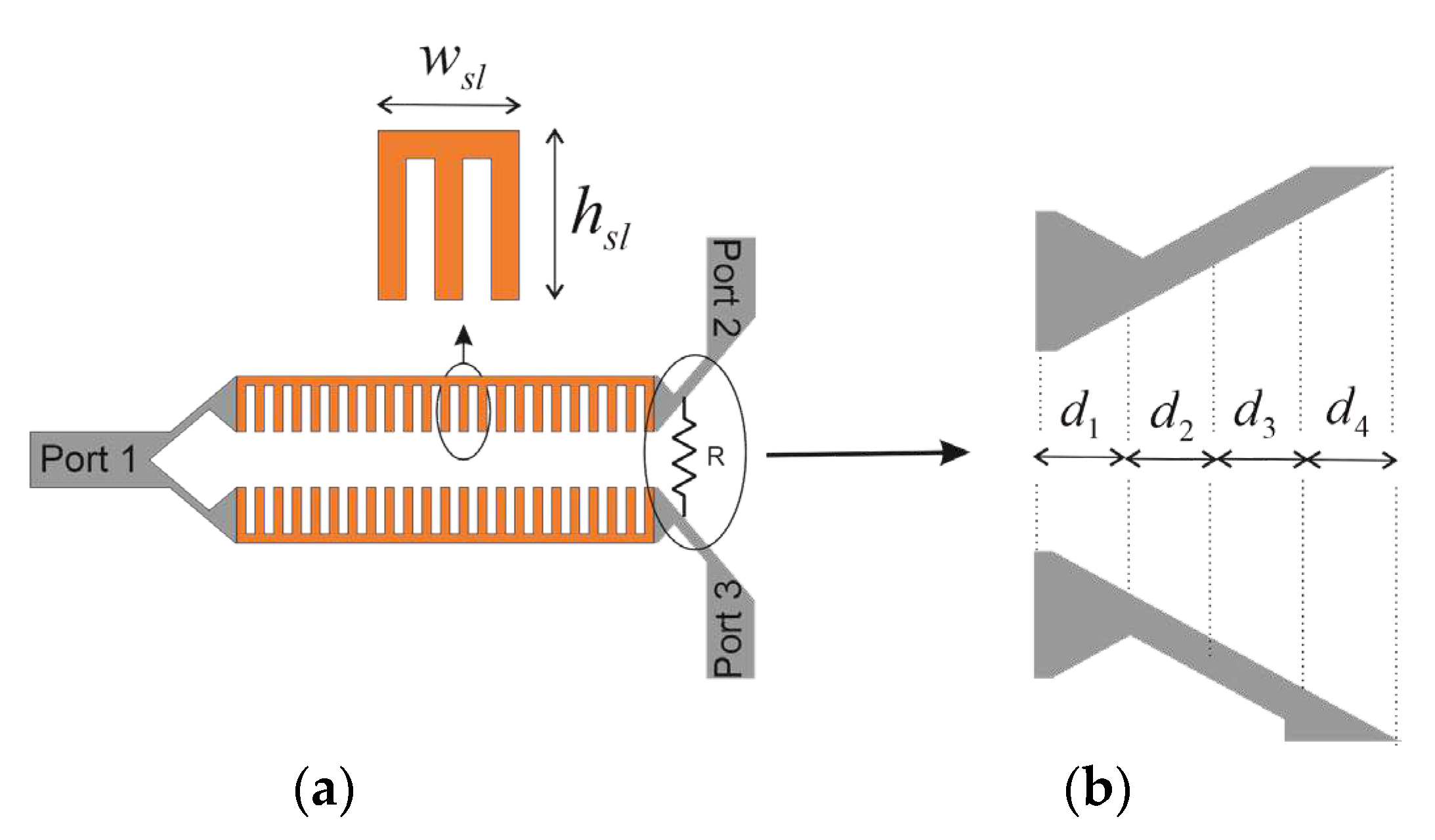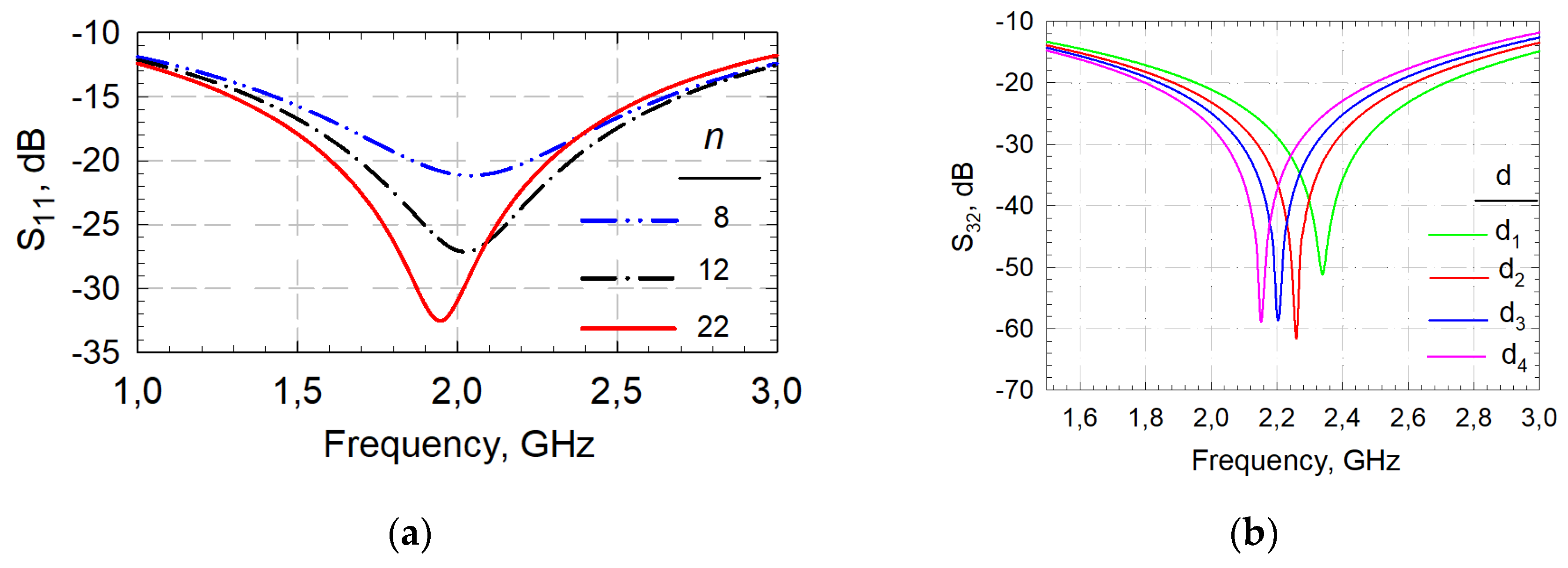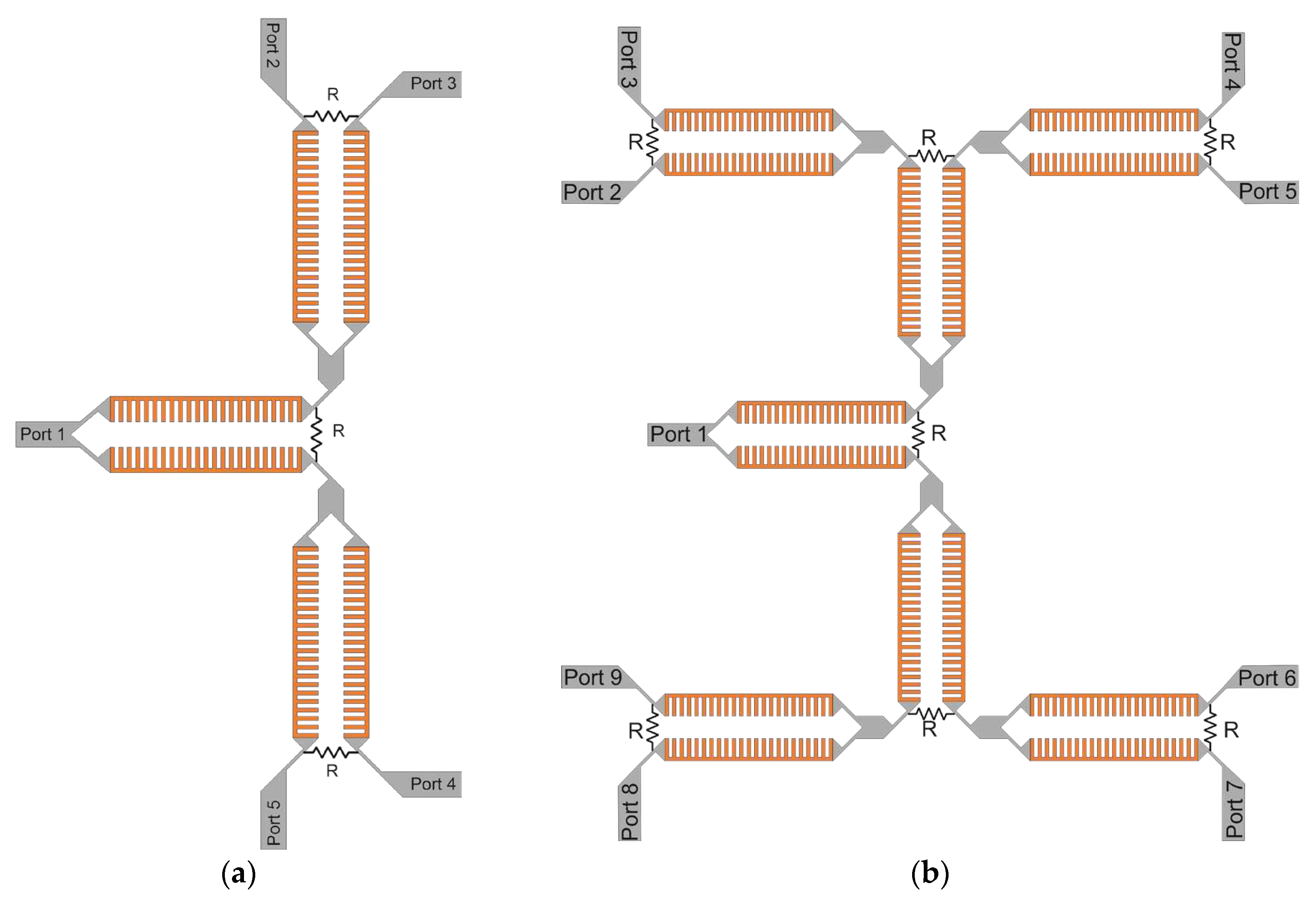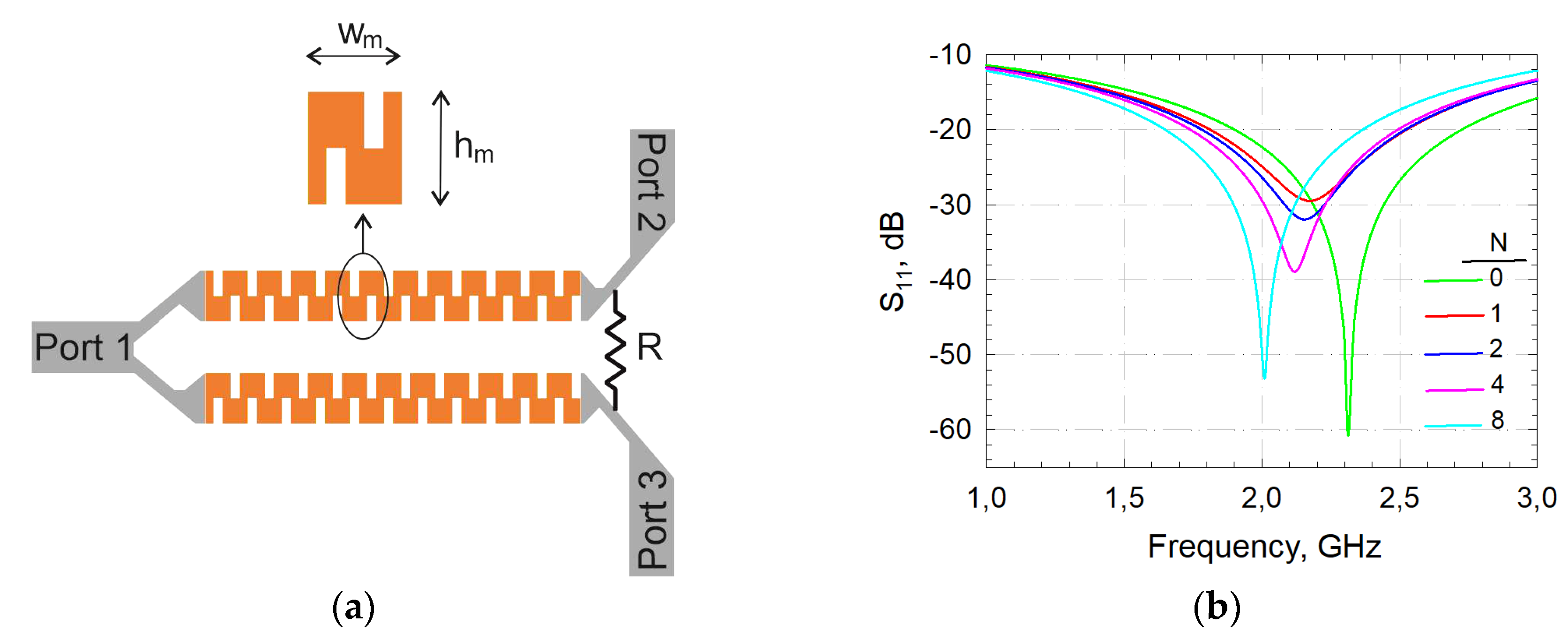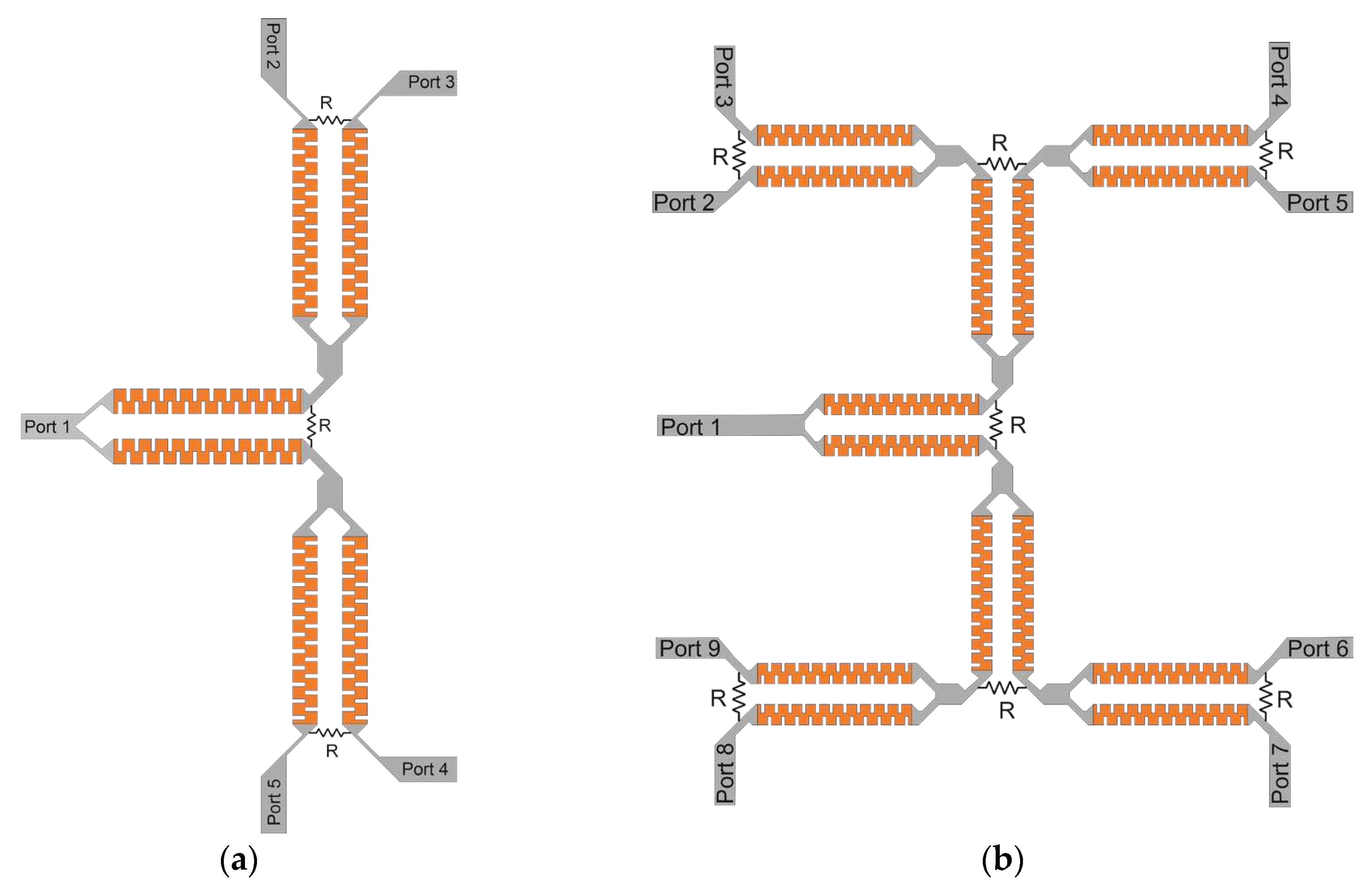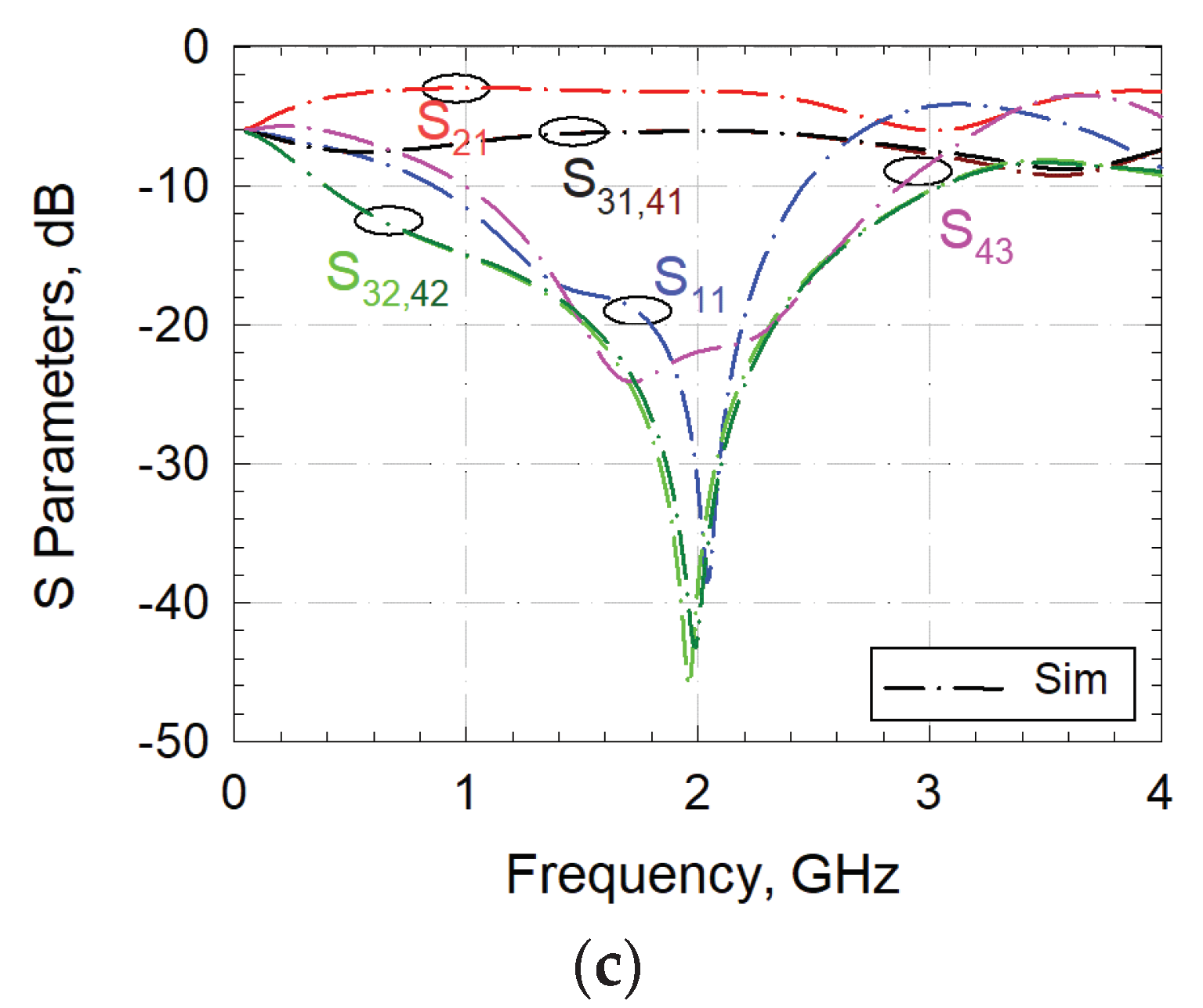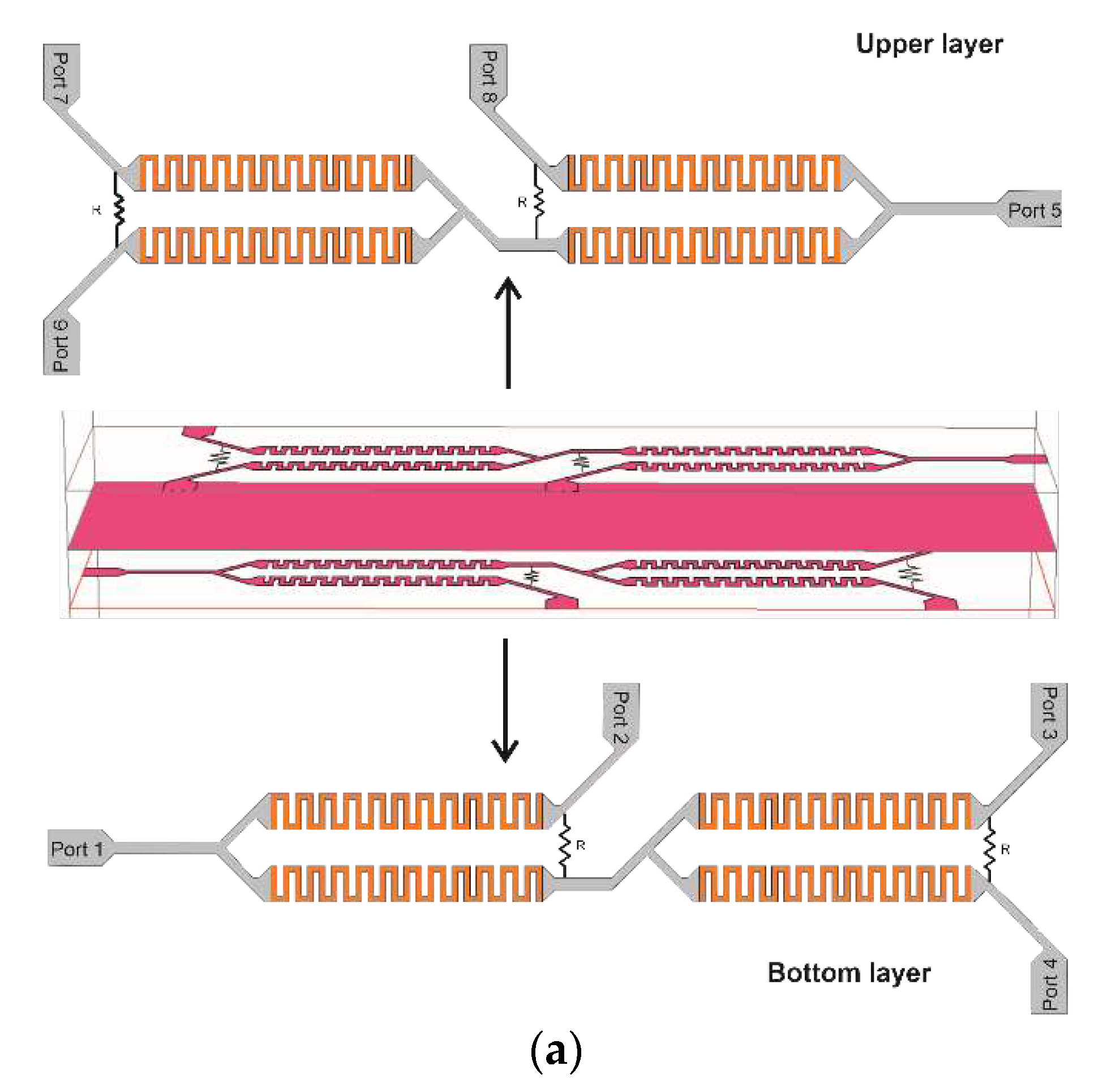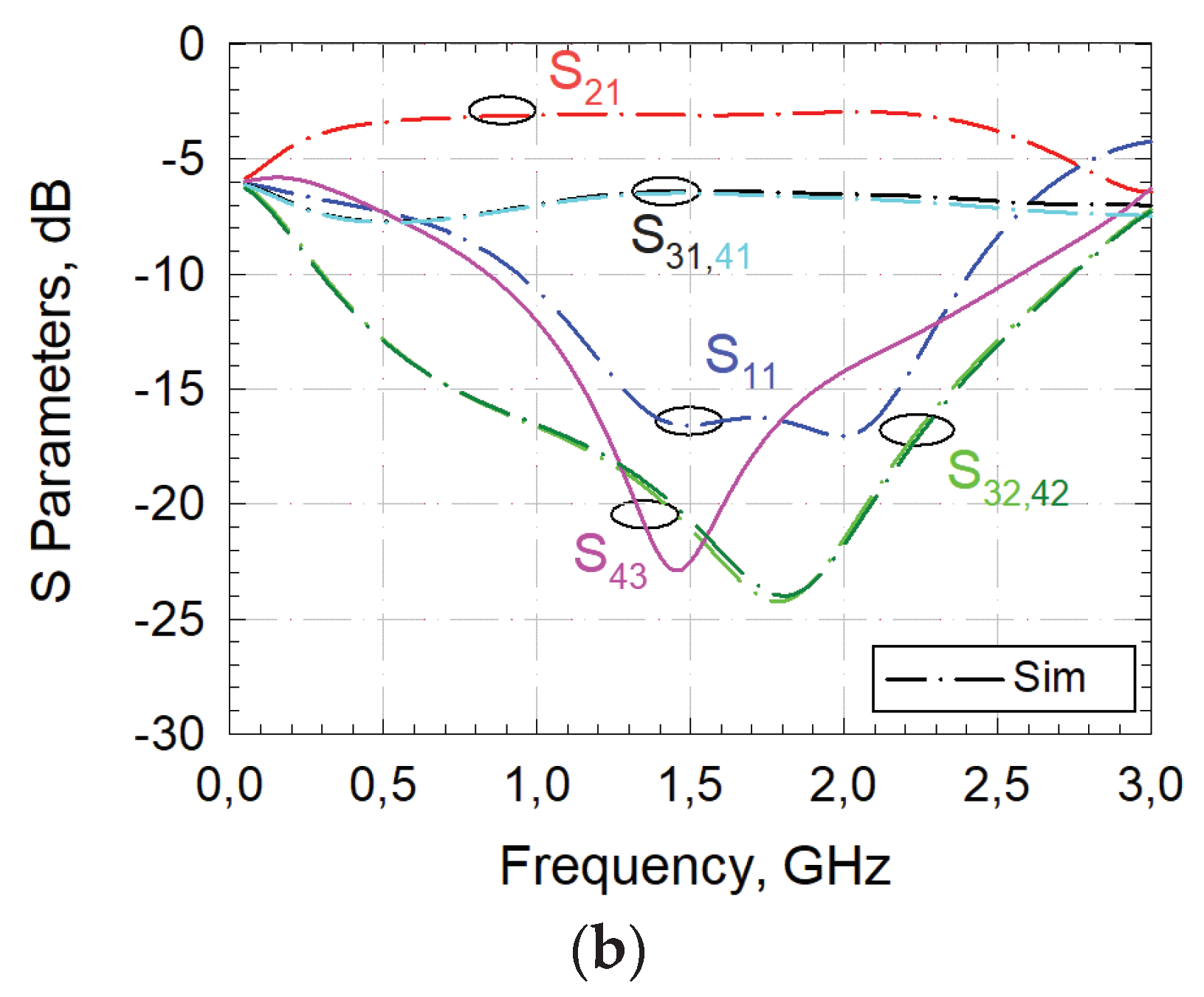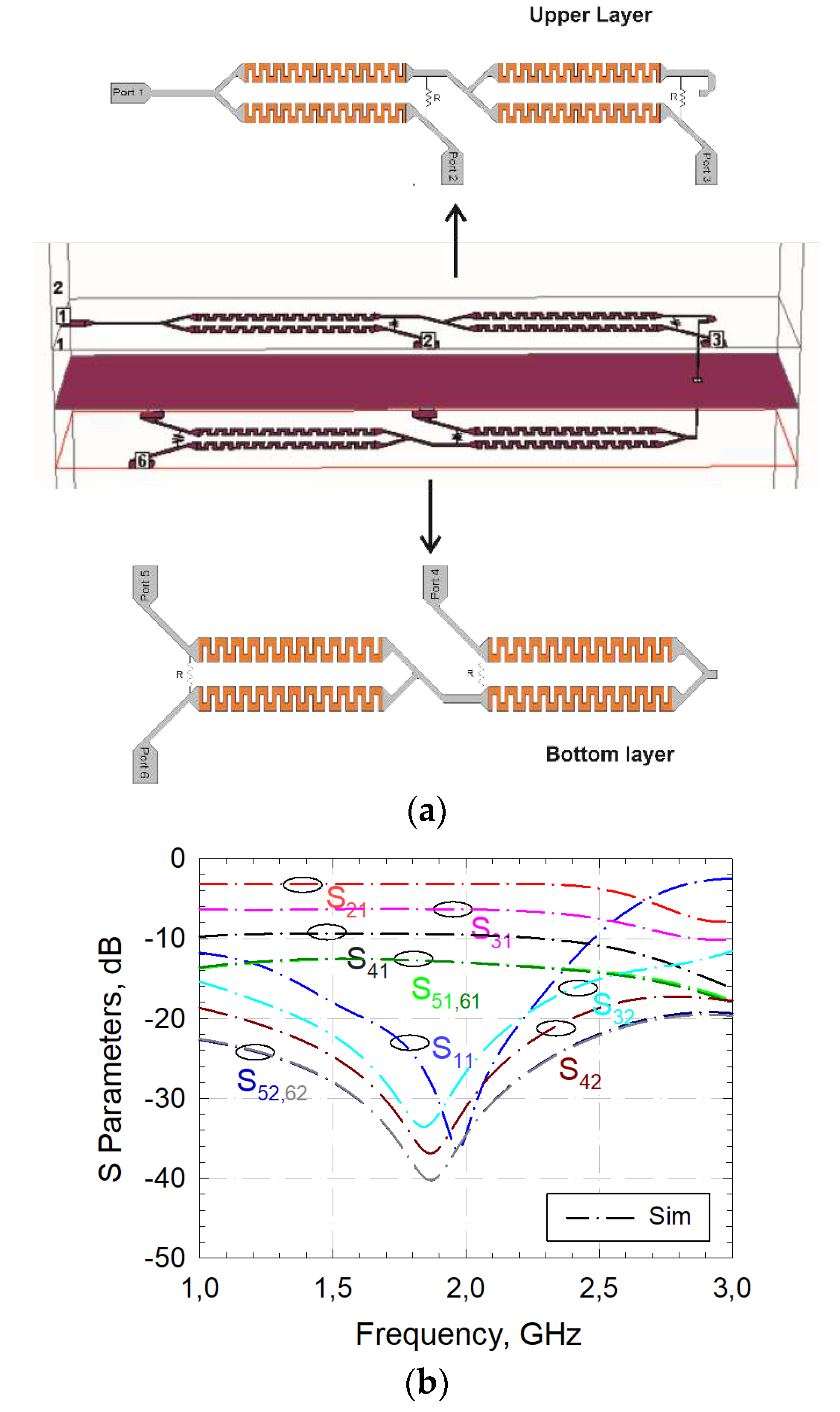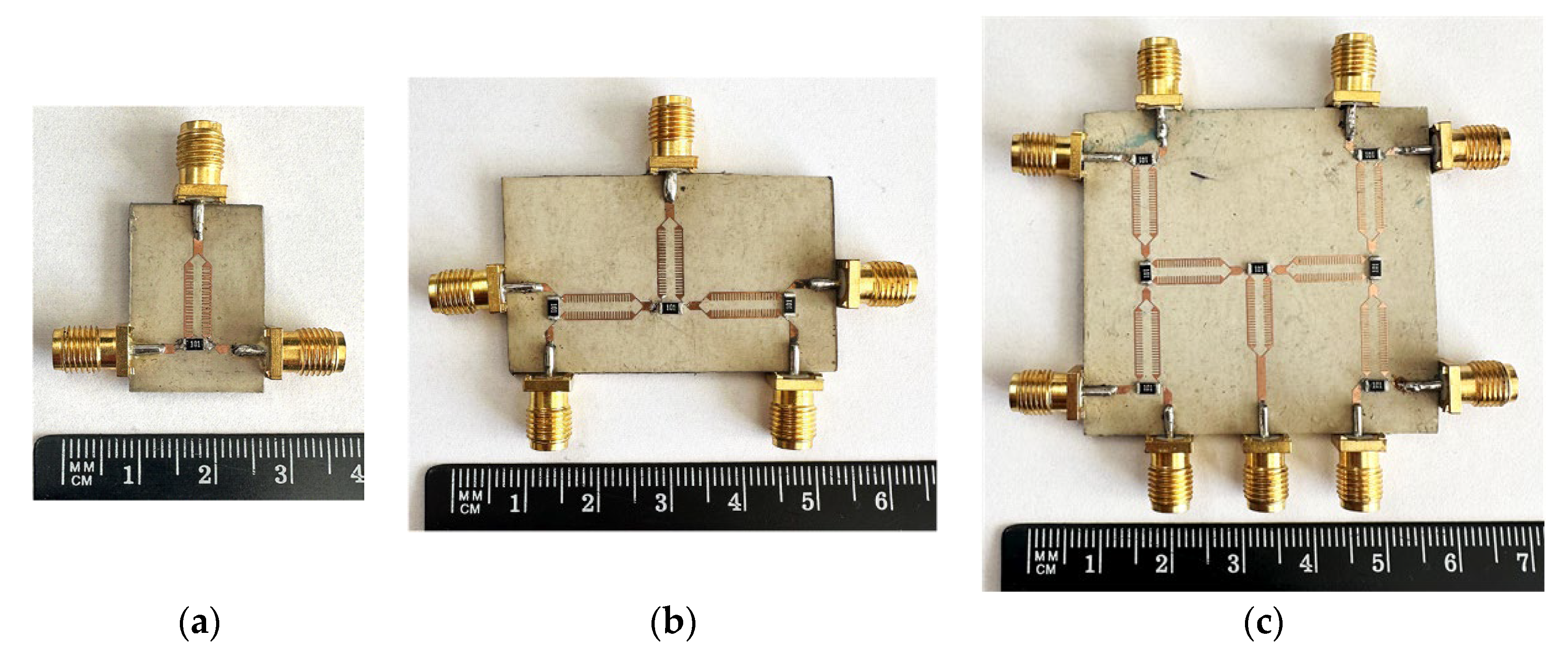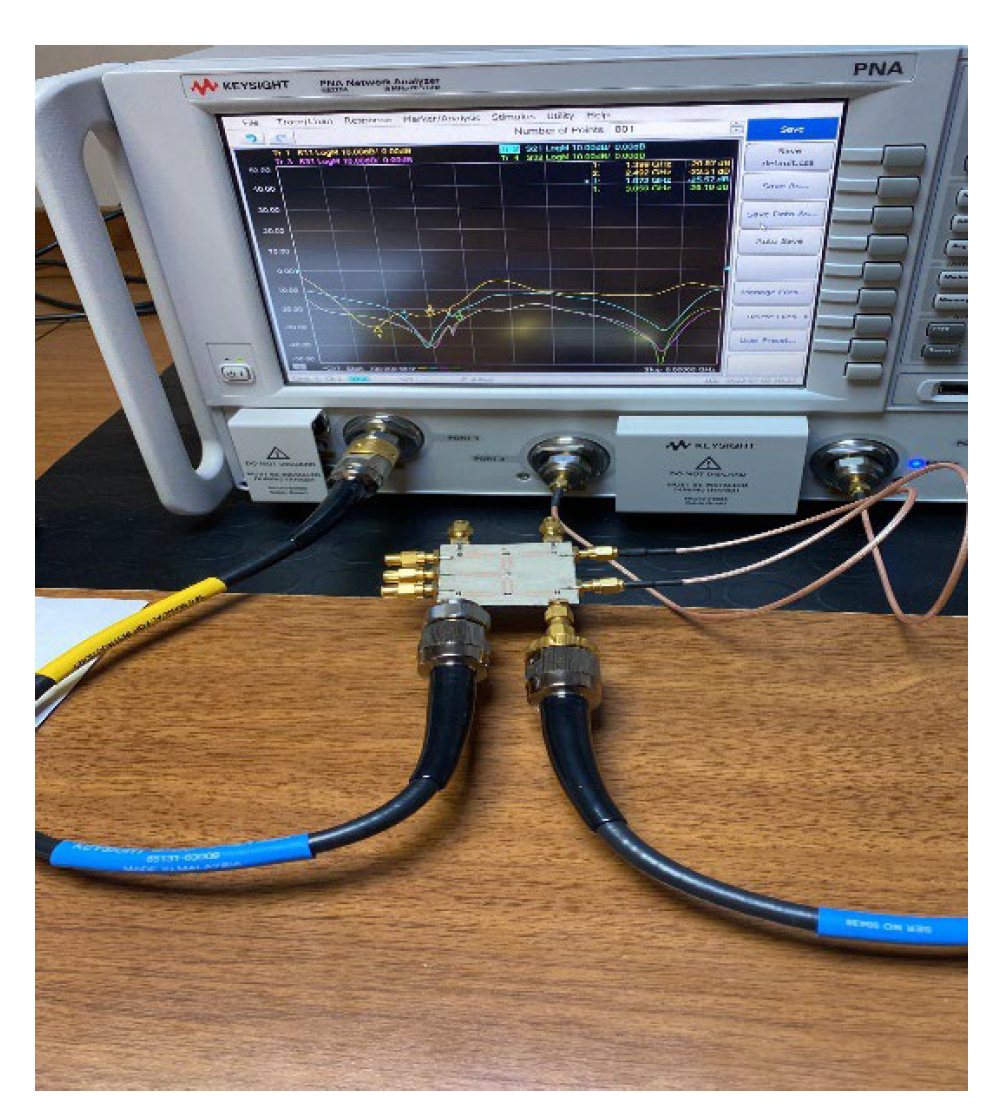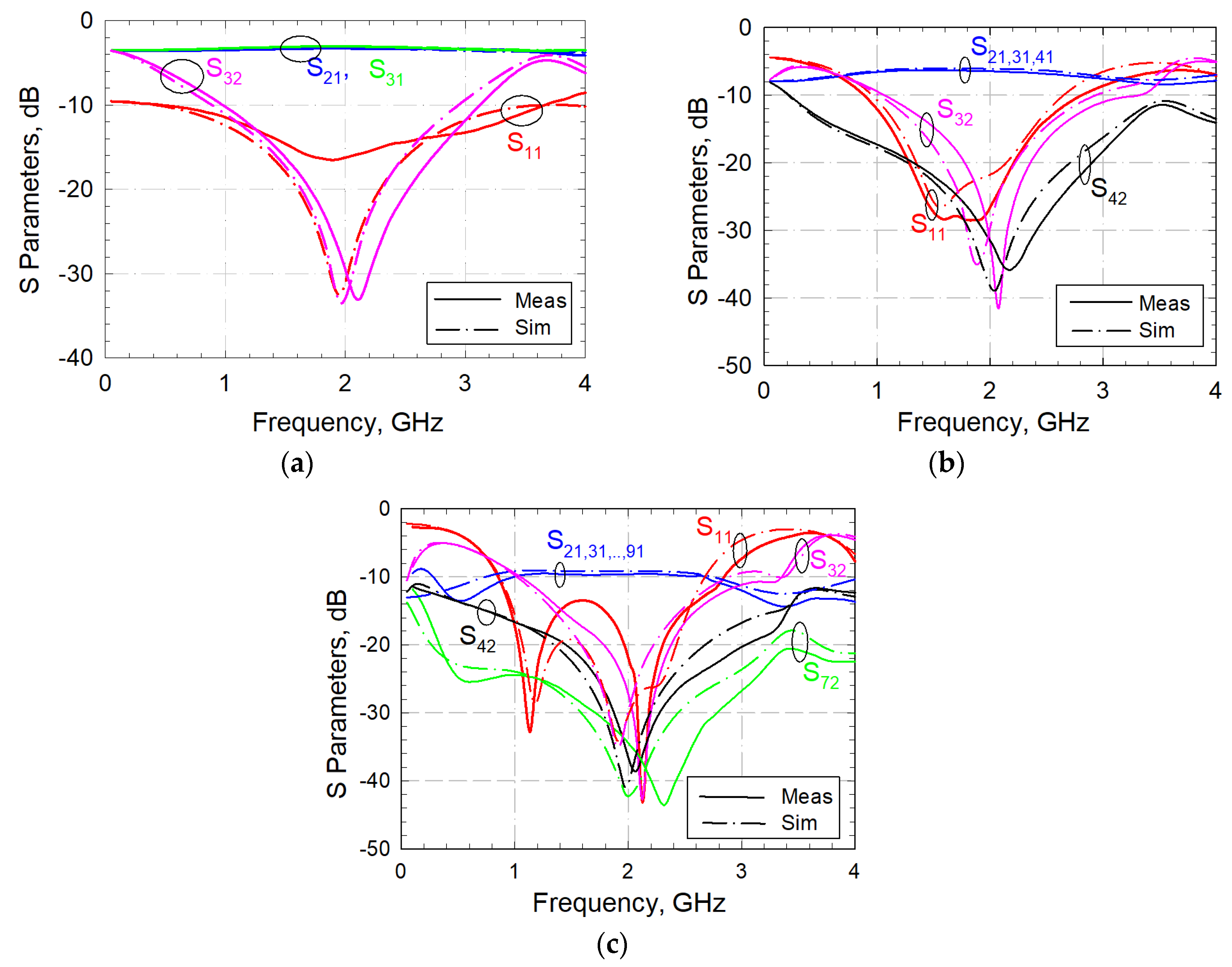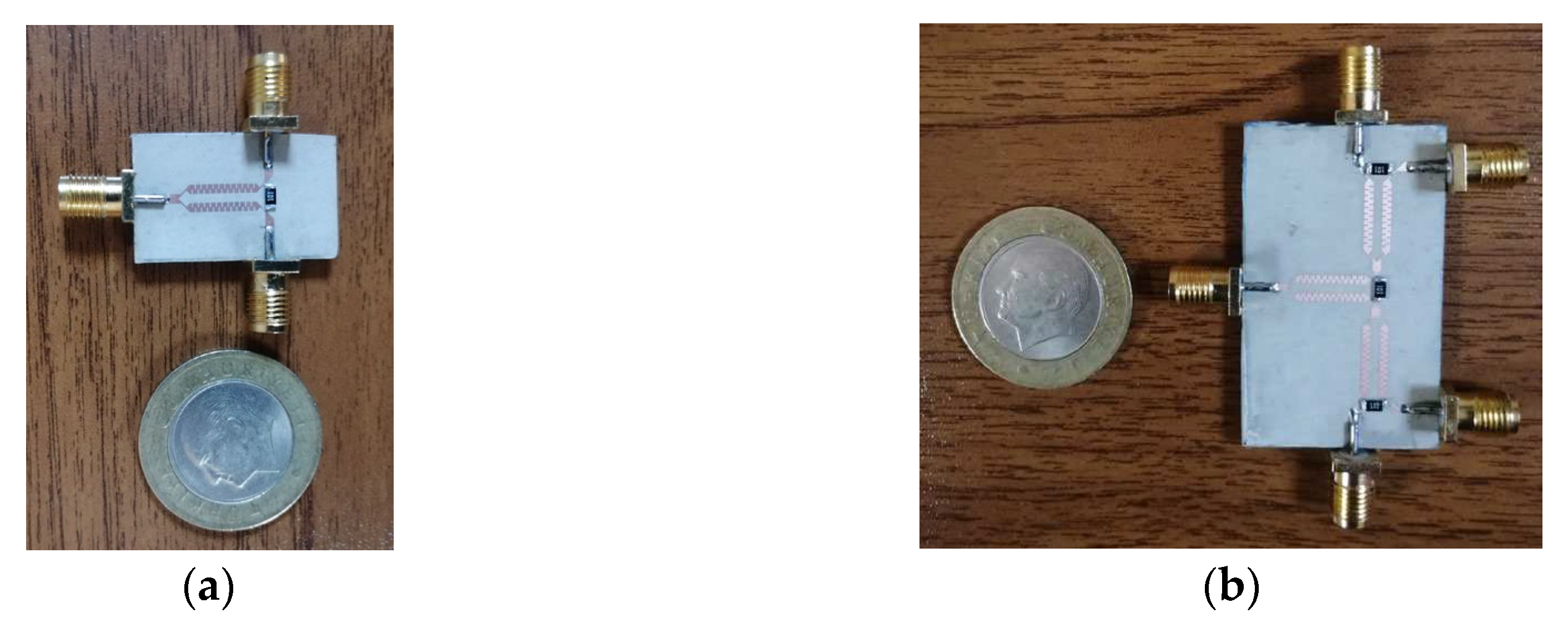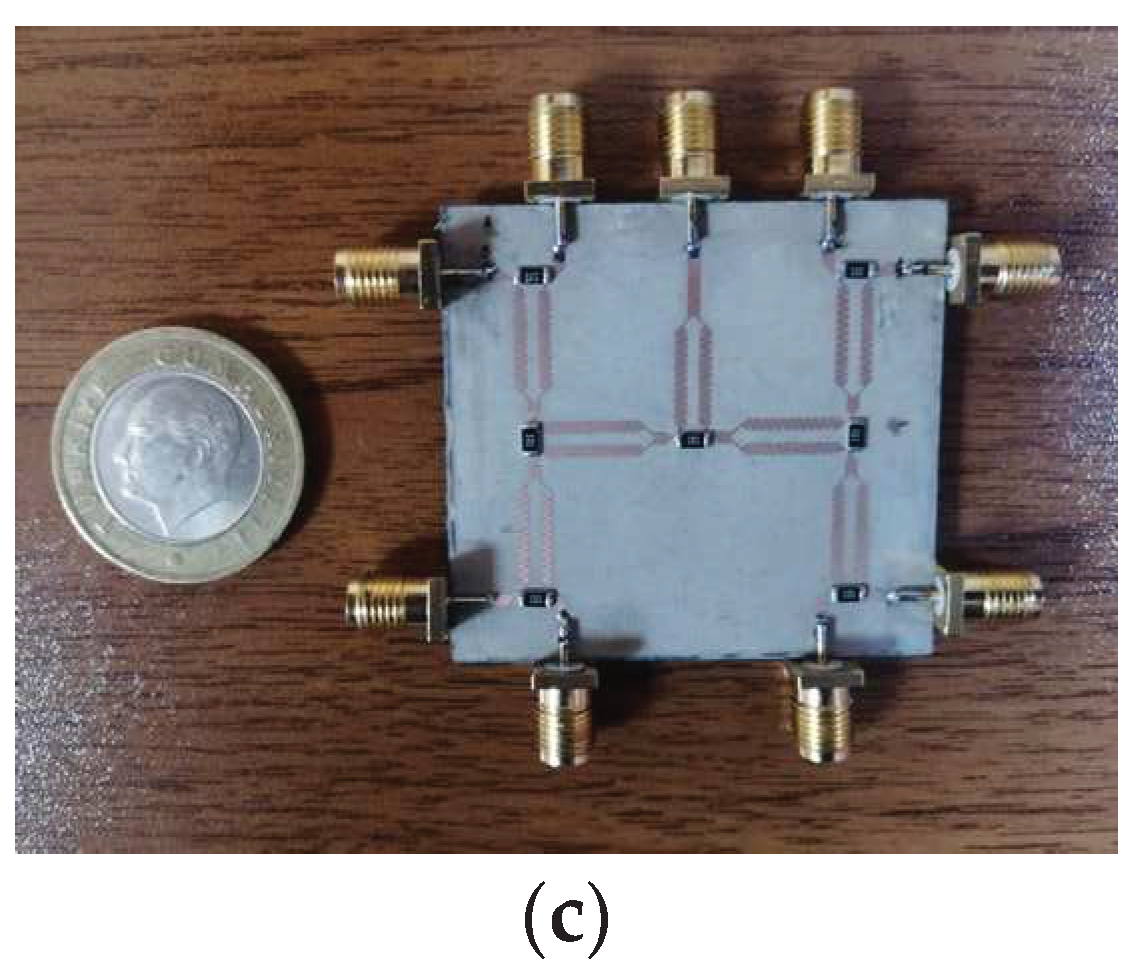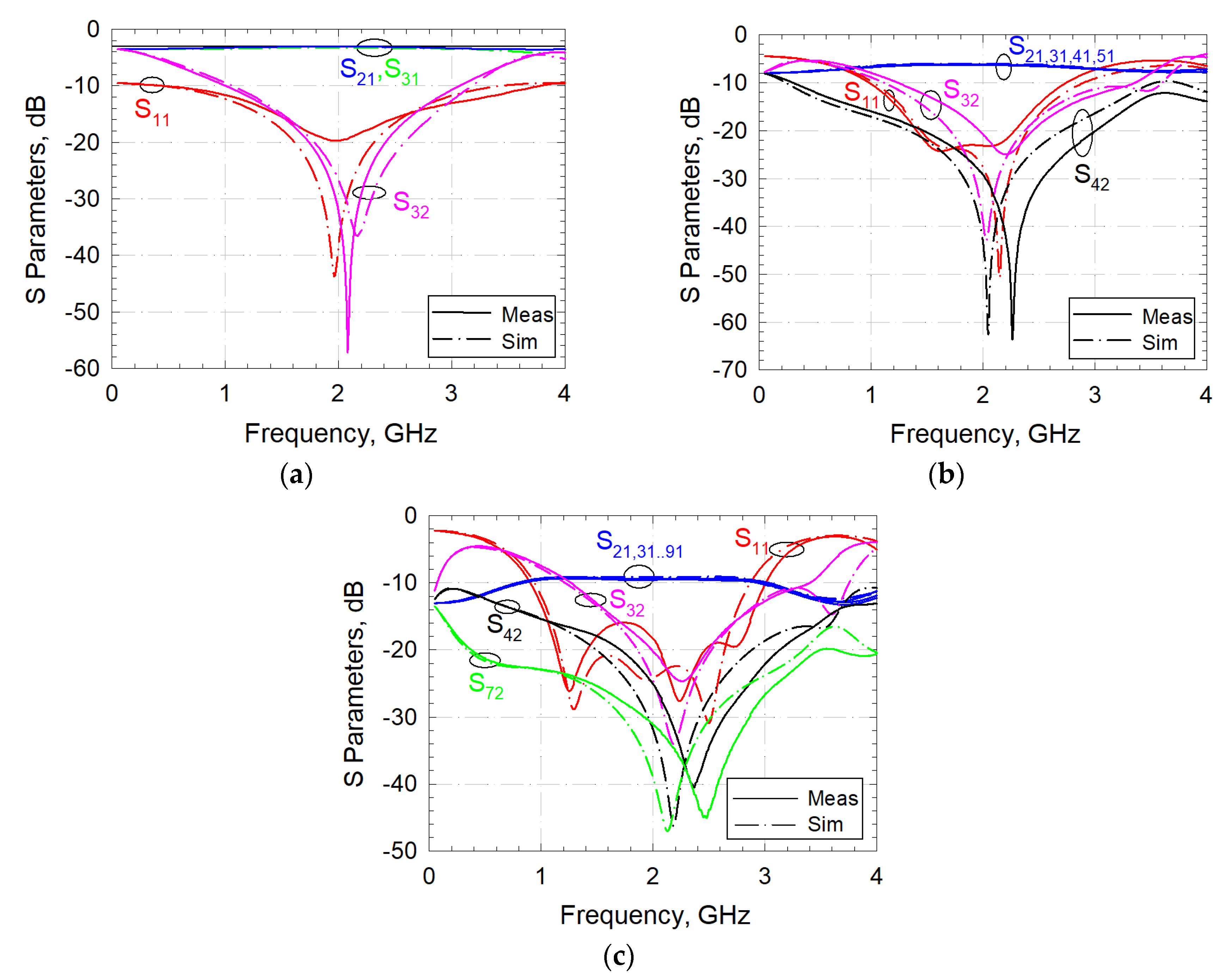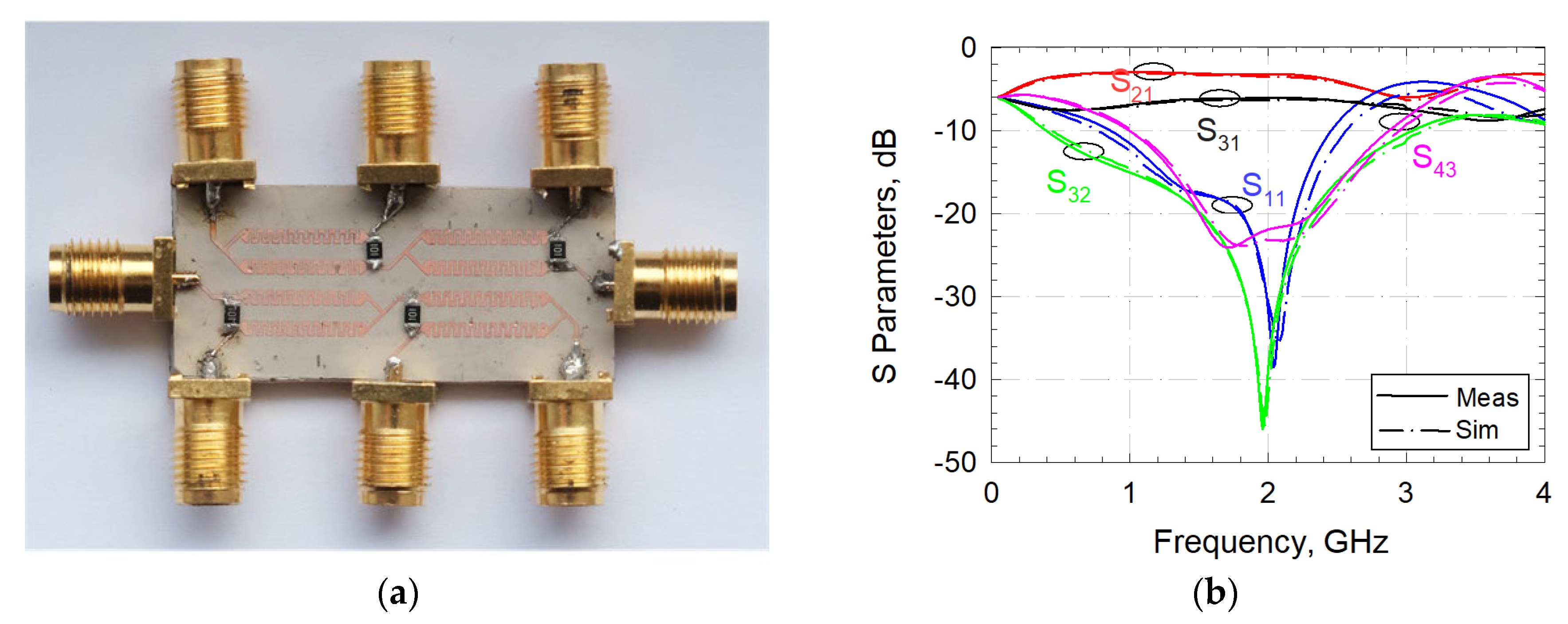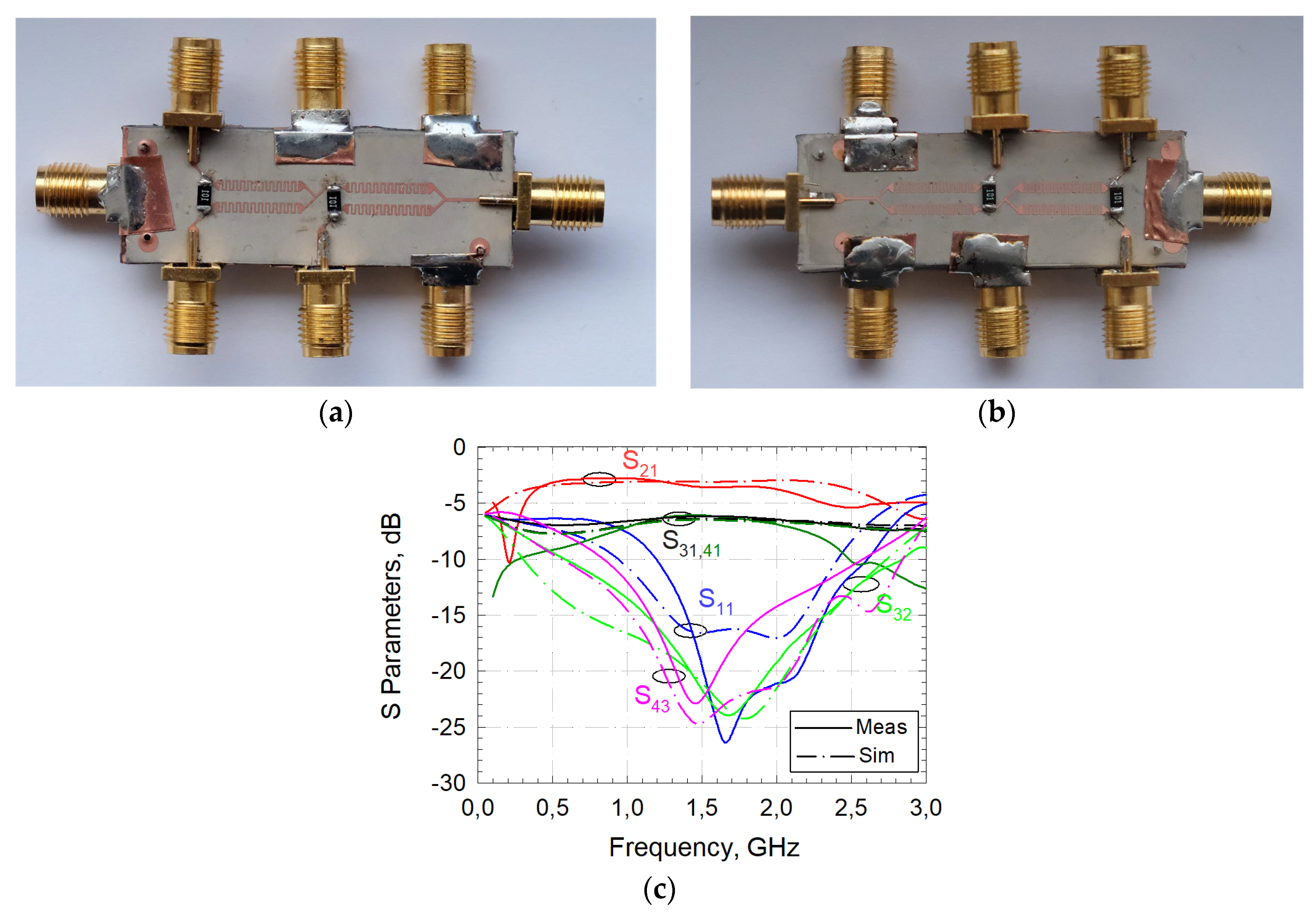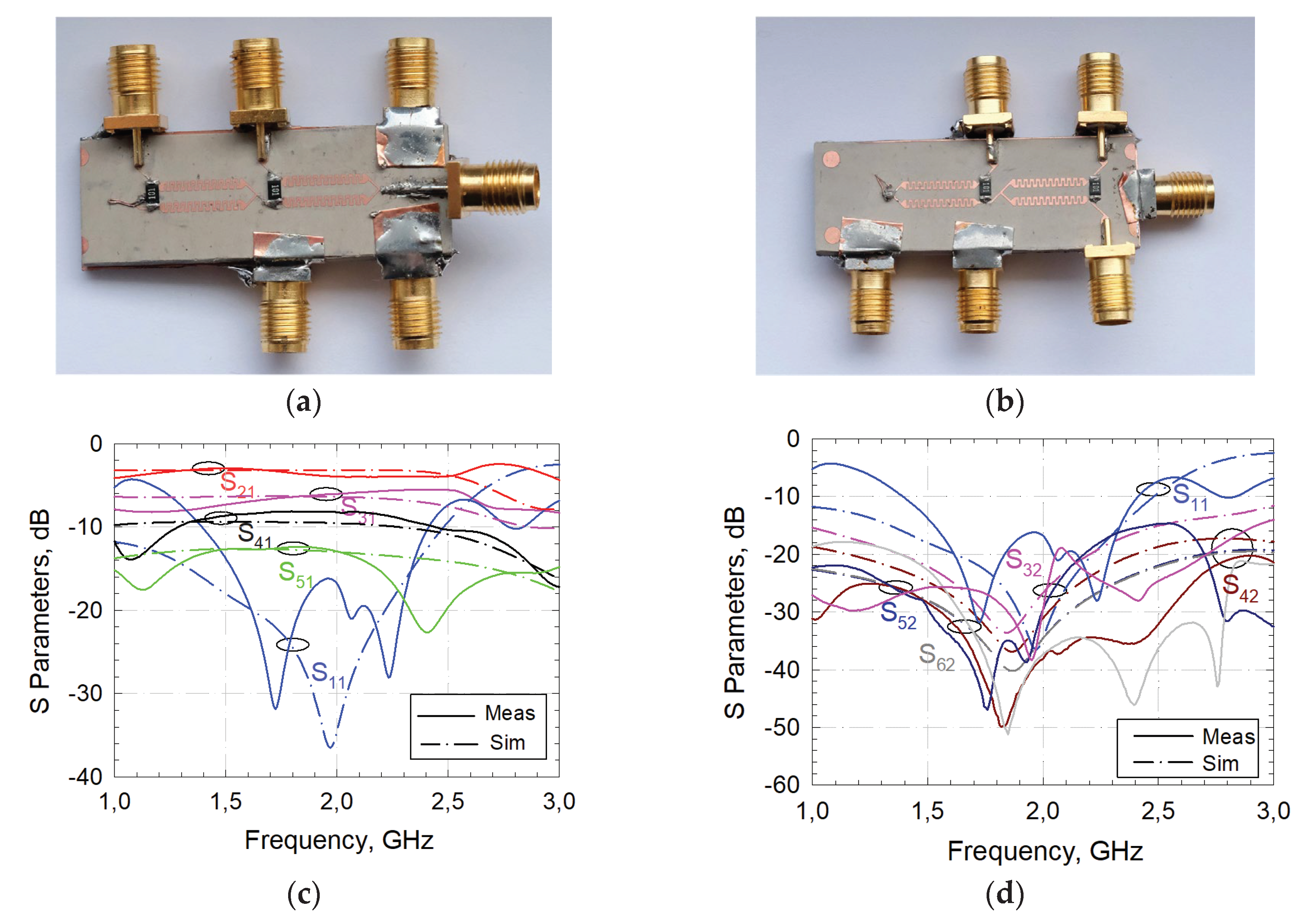1. Introduction
Power dividers are widely used in RF/microwave communication systems since they can play an important role in antenna array elements for proper power splitting ratios. Wilkinson power dividers (WPDs) have an important place among all power dividing/splitting circuits since they can provide high isolation as well as matched input and output ports [
1]. They are one of the essential components used before antenna arrays, so that different types of WPDs allowing various power division processes are highly demanded.
There are different approaches for WPD designs such as utilization of extra stubs, defected ground structures, capacitive loading elements, slow-wave structures, etc. Open-circuited stubs and defected ground structures are used to achieve an improved isolation in [
2,
3,
4,
5,
6]. WPDs operating in a wide frequency band have also been studied with single or multi bands [
7,
8,
9,
10,
11,
12,
13,
14,
15]. Such kind of WPDs may find application areas especially in multifunction communication systems. Moreover, placement of a power divider for an antenna array is one of the main focuses for the researchers. Therefore, size reduction is another important parameter for WPDs since they are required for feeding antenna array elements within a low area. To date, slow wave structures have been used to reduce the circuit size as in [
16,
17,
18,
19]. In some structures, coupling lines are used to suppress undesirable harmonics so that the signal can pass within the desired frequency region [
20,
21,
22,
23]. On the other hand, in order to adjust the directivity, antenna array elements may need different power ratios at different elements. Therefore, unequal power dividers may also find application areas in antenna arrays to meet the requirement of asymmetric power division [
24,
25,
26]. There are two types of equal WPDs including N-way and cascade models. N-way WPDs have one input and N output ports that have impedances of
[
27]. Cascade model WPDs divide input power to 2 at each cascade path [
28].
In this paper, 2-, 4- and 8-way cascade WPDs are designed by using slow wave structures. For this purpose, 2-, 4-, and 8-way WPDs constructed by using narrow slits loaded transmission lines in [
29] have been firstly taken into account. Next, they are replaced with meandered transmission lines to improve the compactness. 2-, 4-, and 8-way WPDs having meandered transmission lines have also been fabricated and successfully measured for demonstration. Based on the meandered transmission lines, 3- and 5-way WPDs with new input/output port arrangements are designed, fabricated and successfully measured for demonstration. The proposed 3- and 5-way circuits allow halving the input power at the next output port.
2. Materials and Methods
2.1. N-Way Wilkinson Power Dividers Based on Slow Wave Structures
As is well known, 1-to-N-way WPDs consist of N branches which have characteristic impedances of
as shown
Figure 1. Although they provide better size reduction than that of the cascade structures, they suffer from the narrow-band and poor isolation between output ports [
27].
Equivalent circuit models for conventional 2-, 4-, and 8-way cascade WPDs are illustrated in Figures 2a, 2b, and 2c, respectively. As can be seen from
Figure 2a, conventional 2-way WPDs comprise of two quarter wavelengths
transmission lines with the characteristic impedances of
. The same transmission line length and impedance values are also valid for 4-, and 8-way WPDs as depicted in Figures 2b and 2c. In order to obtain high isolation between the output ports, an isolation resistor of
is connected between two output ports. In addition, the input/output ports must have characteristic impedances of
for good impedance matching [
2]. S parameters of an ideal WPD can be summarized as follows,
In order to reduce the overall circuit size, quarter wavelength transmission lines can be capacitively or inductively loaded by different approaches as shown in Fig 3. Due to the increment in capacitance or inductance of the transmission line, phase velocity decreases, so that they can be called as slow wave structures. Among the slow wave structures shown in
Figure 3, slot loaded and meandered transmission lines are widely preferred for different kind of microwave circuits because of their easy fabrication processes. However, interdigital capacitor loaded transmission lines are more difficult than the others since they may need extra via connections. As is well known, characteristic impedance (Z
0) and phase velocity (v
p) of a lossless meandered transmission line can be expressed as [
18],
where L and C are the inductance and capacitance per unit length, and
is the effective dielectric constant of the substrate. Moreover, L
m is the inductance per unit length to represent the effects of the meandered structure. Therefore, the characteristic impedance of the meandered transmission line can also be adjusted by loading inductance. The desired characteristic impedance of
can be realized by using different line widths since the proposed meandered line approach can provide inductive loading. The slit loaded transmission lines also exhibit similar slow-wave behavior except L
m. In this case, the slow wave effect is observed due to the increment in the capacitance. Hence, expressions in (2a) and (2b) should be revised as,
2.1.1. WPDs with narrow slits loaded transmission lines
A 2-way WPD is constructed by loading narrow slits as shown in
Figure 4 [
29]. An RT/Duroid substrate with a relative dielectric constant of 10.2 and a thickness of 1.27 mm is used in all design process. Number of slits and location of the isolation resistor affect the frequency response as depicted in Figures 5a and 5b, respectively. It is clear that the center frequency can be decreased, while the number of narrow slits increases. Therefore, a very compact size can be achieved by using maximum number of slits. Since 50 ohm port impedances are utilized, isolation resistor is chosen as 100 ohm.
4- and 8-way WPDs have also been designed by means of the proposed slit loaded transmission lines in [
29].
Figure 6 illustrates the layouts of the 4- and 8-way WPDs in cascade model. It is clear that two more paths have been added instead of output ports for the 4- and 8-way power dividers.
2.1.2. WPDs with meandered transmission lines
In a similar manner with the slit loaded transmission lines, meandered sections can also be used for size reduction.
Figure 7a illustrates a 2-way cascade WPD constructed by meandered transmission lines. An RT/Duroid substrate with a relative dielectric constant of 10.2 and a thickness of 1.27 mm is used in all design process. Effects of the number of meandered sections on the frequency response are depicted in
Figure 7b. Here, the number of meandered sections is changed by starting from the middle of the transmission line. Depending on the proposed approach, a size reduction of %20.14 can be achieved.
In addition to 2-way WPDs, more than two power dividing operation can be necessary for the antenna arrays to be used at multi-way systems. For this purpose, the designed 2-way WPDs can be enhanced to 4-and 8-way circuits by means of the meandered transmission lines as shown in Figures 8a and 8b. As can be seen from
Figure 8a, two 2-way WPDs are connected in cascade for the 4-way design. In this case, two reflection zeros can be observed since there are two identical transmission lines. In the 8-way WPDs, three reflection zeros appear due to the three cascaded transmission lines as shown in
Figure 8b. Here, dimensions of the transmission lines, isolation resistor and resistor position are same with the 2-way WPDs. Accordingly, it is possible to achieve power dividing operations in wider frequency bands by using more cascaded sections. Size reductions for the proposed 4- and 8-way power dividers are 16.62 % and 9.99 %, respectively. Electrical lengths of the proposed 2-, 4-, and 8-way WPDs are 0.20 λ
g x 0.078 λ
g, 0.56 λ
g x 0.25 λ
g, and 0.63 λ
g x 0.57 λ
g, where λ
g is the guided wavelength at the center frequency. Frequency responses of the designed circuits are given with the experimental studies in the following section.
2.1.3. Alternative Input/Output Port Arrangements for Various Power Division Processes
In order to introduce various types of WPDs to be used for different feeding schemes of antenna arrays, new WPD configurations with different power division ratios and input/output port arrangements are proposed by using meandered transmission lines. For this purpose, three different circuit topologies including 3-way, 3-way double layer, and 5-way double layer WPDs are proposed. The main challenge of the proposed circuits is their power halving property. Hence, the input power can be halved at the next output port and the last two ports have equal ratios.
Figure 9 illustrates the circuit for two 3-way WPDs located at the same side of the board. As can be seen from the figure, there are two input ports located at the upper left and bottom right. The upper output ports are belonged to the upper circuit, whereas the bottom output ports are for the bottom circuit. Both of these WPDs perform same operations in different paths, so that the proposed arrangement behaves actually like a power divider bank to be used for a multi input multi output (MIMO) system. They are useful for different antenna arrays serving for different operations. Moreover, the input power is halved at the output port 2 and the powers at the output ports 3 and 4 are equal.
The second WPD configuration is created for double layer applications as shown in
Figure 10. Here, a common ground plane is located between two layers, where both layers include two 3-way power dividers for the utilization in MIMO systems. The power divider in the upper layer is completely similar with the one in the bottom layer, so that the proposed approach is useful for bidirectional MIMO systems. Bottom and upper power dividers exhibit similar circuit performance.
The last configuration is a 5-way WPD as shown in
Figure 11. As can be seen from the figure, two layers are combined so as to have common ground plane. The input port is located at the upper layer and there are five output ports for power splitting. Two of the outputs are in the upper layer, whereas the remaining ports are in the bottom layer. The designed 5-way WPD halves the input power at the next port in a similar manner with the previous configuration. Hence, Port 2 has half, port 3 has 1/4, port 4 has 1/8, Port 5 and Port 6 has 1/16 of the input power.
3. Results
To demonstrate the proposed approaches, all of the designed circuits with narrow slits loaded and meandered transmission lines have been fabricated and tested. All circuits have been simulated by using a Full-Wave Electromagnetic Simulator, Sonnet.
Firstly, experimental studies of the power dividers having narrow slits loaded transmission lines introduced in [
29] are represented. Photographs of the manufactured N-way WPDs having narrow slits in [
29] are shown in
Figure 12.
Figure 13 illustrates a measurement view, where 50 ohm loads were used to match the idle output ports for 4- and 8-way power dividers since the device has only four ports. The measured results of the power dividers having narrow slits loaded transmission lines are compared with the simulations in
Figure 14 [
29]. It is obvious that the measured and simulated results have been observed in a very good agreement. In
Figure 14a, center frequency is 2 GHz with the 15 dB fractional bandwidth (FBW) of 36.26 %. As can be seen from the figure, the return loss and isolation level are better than 15 and 20 dB within the FBW, respectively. Within the FBW, minimum isolation and insertion loss are about 29.56 dB at 2 GHz and 3.29 dB, respectively. The measured and simulated results of the 4-way WPD are illustrated in
Figure 14b with the return loss and isolation levels of better than 15 and 20 dB, respectively. The center frequency is 1.8 GHz with the FBW of 94.44% and insertion loss of better than 3+0.5 dB. Moreover, the center frequency of 8-way WPD has been measured at 1.9 GHz with the FBW of 81.05 %. The measured results are compared with the simulated ones in
Figure 14c, where the insertion loss, return loss, and isolation levels have been obtained as better than 9+0.5, 15 and 20 dB, respectively.
Meandered transmission lines based 2-, 4-, and 8-way WPDs have also been manufactured and tested. Photographs of the fabricated circuits are shown in
Figure 15. Return loss and isolation level is better than 15 and 30 dB, respectively. Frequencies of the minimum isolation and return loss levels are different because of fabrication errors. It should also be noted that there is only one reflection zero within the related frequency band. The center frequency of the 4-way power divider has been measured at 1.77 GHz with the FBW of 73.09 % as depicted in
Figure 16b. At that frequency, the measured return and insertion losses are 24 and 3.1 dB, respectively. Isolations between the output ports have been measured as better than 26 dB. In the frequency response of 4-way power divider, there are two reflection zeros since the circuit is comprised of two cascaded sections. The simulated and measured results of the 8-way WPD are demonstrated in
Figure 16c in a very good agreement. In this case, three reflection zeros can be observed due to the utilization of three cascaded sections. The center frequency has been measured at 1.73 GHz with the 15 dB FBW of 87.86 %. Isolation levels between the output ports are better than 15 dB, 26 dB, 24 dB within the FBW, where the minimum insertion losses are 3.6 dB, 6.5, 9.6 for 2-, 4-, and 8-way WPDs, respectively.
Meandered transmission lines based WPDs with alternative input/output port configurations have been manufactured and tested for demonstration. Photograph of the fabricated two 3-way WPDs is shown in
Figure 17a. Frequency response of the designed power divider is depicted in
Figure 17b. As can be seen from the figure, the designed circuit can serve within the frequency band of 1.5-2.0 GHz. Within the frequency region, isolation between the output ports are better than 19.96 dB, return loss is better than 17.71 dB and insertion loss is better than 3+0.5 dB.
The multilayer 3-way WPD has been implemented as shown in Figures 18a and 18b. It is obvious that the implemented circuit is different than the previous one, since two WPDs are located at both sides of the structure with a common ground plane. Comparisons of the simulated and measured results in terms of return loss, insertion loss and isolation level are depicted in
Figure 18c. Within the frequency band of 1.5-2 GHz, the return loss is observed as better than 15 dB with an insertion loss of better than 3+0.5 dB at each output port. Furthermore, the isolation levels between all output ports are better than 19 dB.
Meandered transmission lines based multilayer 5-way WPD has also been manufactured and successfully tested. Photographs of the fabricated circuits are shown in Figures 19a and 19b for the front and back views, respectively. The measured and simulated return and insertion losses of the proposed 5-way power divider are compared in
Figure 19c in an acceptable agreement. Furthermore, the measured and simulated isolation levels between the output ports are also depicted in
Figure 19d. It is clear that the proposed multilayer 5-way WPD can be used for different communication systems. Within the frequency band of 1.5-2 GHz, return loss, insertion loss and isolation levels are better than 16.52, 3+0.5, and 14.47 dB, respectively. The differences betwween the measured and simulated responses are resulted from the fabrication errors and especially from the layer combining process.
Table 1 summarizes and compares the measurements of the proposed design with the work published in the literature.
4. Conclusions
In this study, various types of WPDs have been developed and experimentally investigated by using slow wave structures. For this purpose, WPDs having narrow slits loaded transmission lines have been investigated and novel meandered transmission lines based WPDs have been firstly introduced. The proposed meandered lines based 2-, 4-, and 8-way power dividers have been fabricated and measured successfully. The proposed meandered transmission lines have also been used to design new types of WPDs with new input/output port arrangements. In this context, two 3-way WPDs have been located on the same plane for similar power splitting process. Next, this circuit has been developed by locating one of the power dividers to another layer. The proposed circuits can behave like a power divider bank to be used for alternative antenna array applications. Moreover, a 5-way WPD has been designed by using meandered transmission lines in two layers. These alternative WPD topologies allow halving the input power at the next output port. They have been implemented and measured in an acceptable agreement with the simulated results.
Author Contributions
Conceptualization, M.C., A.K.G., C.K. and A.G.; methodology, M.C., A.K.G., C.K. and A.G.; software, M.C., A.K.G., C.K. and A.G.; validation, M.C., A.K.G., C.K. and A.G.; investigation, M.C., A.K.G., C.K. and A.G.; resources, M.C., A.K.G., C.K. and A.G.; writing—original draft preparation, M.C., A.K.G., C.K. and A.G.; writing—review and editing, M.C., A.K.G., C.K. and A.G.; visualization, M.C., A.K.G., C.K. and A.G.; supervision, C.K. and A.K.G.; project administration, A.G. All authors have read and agreed to the published version of the manuscript.
Funding
This research received no external funding.
Data Availability Statement
Data and simulation files will be shared upon request from the authors.
Acknowledgments
This work was supported by the Scientific and Technological Research Council of Turkey (TUBITAK) under Grant 120E101.
Conflicts of Interest
The authors declare no conflict of interest.
References
- Wilkinson, E.J., A N-way hybrid power divider, IRE Trans. Microwave Theory & Tech., 1960, 8, 116-118. [CrossRef]
- Razzaz, F; Saeed, S.M.; Alkanhal, M.A.S., Compact Ultra-Wideband Wilkinson Power Dividers Using Linearly Tapered Transmission Lines, Compact Ultra-Wideband Wilkinson Power Dividers Using Linearly Tapered Transmission Lines, Electronics, 10(19), 2022. [CrossRef]
- Omi, A. I., Zafar, Z. N., Al-Shakhori, H., Savage, A. N., Islam, R., Maktoomi, M. A., Zakzewski, C.; Sekhar, P., A new analytical design methodology for a three-section wideband wilkinson power divider, Electronics, 10(19), 2021. [CrossRef]
- Gao, N.; Wu, G.; Tang, Q., Design of a novel compact dual-band wilkinson power divider with wide frequency ratio, IEEE Microwave and Wireless Components Letters, 2014, 24(2), 81–83. [CrossRef]
- Chen, Y.; Zhang, X.Y., Liu, F.X.; Lee, J.C., A Compact Bandpass Wilkinson Power Divider with Ultra-Wide Band Harmonic Suppression, IEEE Microwave and Wireless Components Letters, 2017, 27(10), 888–890. [CrossRef]
- Saxena, A., Hashmi, M., Banerjee, D., & Chaudhary, M. A., Theory and design of a flexible two-stage wideband wilkinson power divider. Electronics, 10(17), 2021. [CrossRef]
- Liang, W. F.; Hong, W.; Chen, J.X., A Q-band compact Wilkinson power divider using asymmetrical shunt-stub in 90nm CMOS technology, Asia-Pacific Microwave Conference Proceedings, APMC, 2012, 974–976.
- Kawai T.; Nagano, K.; Enokihara, A., Dual-Band Semi-Lumped-Element Power Dividers at UHF/SHF Bands, 50th European Microwave Conference, EuMC, 2020, 844–847.
- Santiko, A.B.; Munir, A., Development of dual band power divider using meander line technique for local oscillator system, IEEE 13th International Conference on Telecommunication Systems, Services, and Applications (TSSA), Bali, Indonesia, Oct. 2019, 286–289.
- Xia, Y., Wei, F., & Shi, X., A Novel Filtering Power Divider Based on Ring Resonator. International Journal of Antennas and Propagation, 2022. [CrossRef]
- Park, M. J.; Lee, B., A dual-band Wilkinson power divider, IEEE Microwave and Wireless Components Letters, 2008, 18(2), 85–87.
- Wu, Y.; Liu, Y.; Zhang, Y.; Gao, J.; Zhou, H., A dual band unequal wilkinson power divider without reactive components, IEEE Transactions on Microwave Theory and Techniques, 57(1), 216–222, 2009. [CrossRef]
- Shamaileh, K. A.; Dib, N.; Abushamleh, S.A., Dual-Band 1:10 Wilkinson Power Divider Based on Multi-T-Section Characterization of High-Impedance Transmission Lines, IEEE Microwave and Wireless Components Letters, 2017, 27(10), 897–899. [CrossRef]
- Lee, S.; Park, J.; Hong, S., Millimeter-Wave Multi-Band Reconfigurable Differential Power Divider for 5G Communication, IEEE Transactions on Microwave Theory and Techniques, 2022, 70(1), 886–894. [CrossRef]
- Gómez-García; R.,Loeches-Sánchez; R, Psychogiou, D.; Peroulis, D., Single/multi-band Wilkinson-type power dividers with embedded transversal filtering sections and application to channelized filters, IEEE Transactions on Circuits and Systems I: Regular Papers, (2015), 62(6). [CrossRef]
- Rawat, K.; Ghannouchi, F.M., A design methodology for miniaturized power dividers using periodically loaded slow wave structure with dual-band applications, IEEE Transactions on Microwave Theory and Techniques, 2009, 57(12), 3380–3388. [CrossRef]
- Karpuz, C.; Gorur, A.K. Gorur, Effects of narrow slits on frequency response of a microstrip square loop resonator and dual-mode filter applications, Microw. Opt. Technol. Lett., 2012, 55: 143-146. [CrossRef]
- Kim, K.; Nguyen C., An ultra-wideband low-loss millimeter-wave slow-wave wilkinson power divider on 0.18 μm SiGe BiCMOS process, IEEE Microwave and Wireless Components Letters, 2015, 25(5), 331–333, 2015. [CrossRef]
- Abdelrahman,B.M.; Ahmed, H.N.; Shehata, K.A., A miniaturized, broadband power divider using loaded slow wave structures for wireless applications, National Radio Science Conference NRSC, 2016, 356–361.
- Roshani, S., Koziel, S., Roshani, S., Hashemi Mehr, F. S.; Szczepanski, S., Design and Implementation of a Dual-Band Filtering Wilkinson Power Divider Using Coupled T-Shaped Dual-Band Resonators, Energies, 15(03), 2022. [CrossRef]
- Roshani, S., Yahya, S. I., Alameri, B. M., Mezaal, Y. S., Liu, L. W. Y.; Roshani, S., Filtering Power Divider Design Using Resonant LC Branches for 5G Low-Band Applications, Sustainability, 14(19), 2022. [CrossRef]
- Wu, L.; Yilmaz, H.; Bitzer, T.; Pascht, A.; Berroth, M., A dual-frequency wilkinson power divider: For a frequency and its first harmonic, IEEE Microwave and Wireless Components Letters, 2005, 15(2), 107–109. [CrossRef]
- Wu, J.; E. Li and G. F. Guo, Microstrip power divider with capacitive stubs loading for miniaturization and harmonic suppression, ICMTCE2011 - Proceedings 2011 IEEE International Conference on Microwave Technology and Computational Electromagnetics, 237–239, 2011.
- Sallam, T., Attiya, A. M., Neural network inverse model for multi-band unequal Wilkinson power divider. COMPEL - The International Journal for Computation and Mathematics in Electrical and Electronic Engineering, 41(5), 2022, 1604–1617. [CrossRef]
- Cheng, J. D., Xia, B., Xiong, C., Wu, L. S., & Mao, J. F., Peng An Unequal Wilkinson Power Divider Based on Integrated Passive Device Technology and Parametric Model. IEEE Microwave and Wireless Components Letters, 32(4), 281–284, 2022. [CrossRef]
- Peng, C., Ye, Z., Wu, J., Chen, C.; Wang, Z., Design of a wide-dynamic rf-dc rectifier circuit based on an unequal wilkinson power divider., Electronics, 10(22), 2021. [CrossRef]
- Hesham, B., Islam, A. E., Mohamed, A. Y. A., Ahmed. N. M., A Compact Low-Loss On-chip N-Way Wilkinson Power Divider for mm-Wave 5G Applications, 2020 IEEE 63rd International Midwest Symposium on Circuits and Systems (MWSCAS): online proceedings : August 9-12, 2020.
- Al-Hindawi, A. M. J. , Design forms of branching lines for microstrip power dividers. 33rd IEEE Sarnoff Symposium 2010, Conference Proceedings, 2010. [Google Scholar] [CrossRef]
- Karpuz, C., Gorur A.K., Cakir M., Cengiz A., Gorur A., Compact Wilkinson Power Dividers Based on Narrow Slits Loaded Transmission Lines, IEEE Radio and Wireless Symposium, 2023.
Figure 1.
Conventional 1-to-N way WPD.
Figure 1.
Conventional 1-to-N way WPD.
Figure 2.
Conventional cascade WPDs a) 2-way; b) 4-way; c) 8-way.
Figure 2.
Conventional cascade WPDs a) 2-way; b) 4-way; c) 8-way.
Figure 3.
Slow wave structures (a) Slot loaded; (b) Meandered; (c) Interdigital.
Figure 3.
Slow wave structures (a) Slot loaded; (b) Meandered; (c) Interdigital.
Figure 4.
a) Conventional 2 way WPD loading narrow slits; b) Location of isolation resistor.
Figure 4.
a) Conventional 2 way WPD loading narrow slits; b) Location of isolation resistor.
Figure 5.
a) Effects of narrow slits on the frequency response; b) Effects of locations of isolation resistor on the frequency response.
Figure 5.
a) Effects of narrow slits on the frequency response; b) Effects of locations of isolation resistor on the frequency response.
Figure 6.
a) 4-way WPD loading narrow slits; b) 8 - way WPD loading narrow slits.
Figure 6.
a) 4-way WPD loading narrow slits; b) 8 - way WPD loading narrow slits.
Figure 7.
(a) Conventional 2-way WPD having meandered transmission lines; (b) Effects of WPD meandering on the frequency response.
Figure 7.
(a) Conventional 2-way WPD having meandered transmission lines; (b) Effects of WPD meandering on the frequency response.
Figure 8.
Conventional WPDs having meandered transmission lines, (a) 4-way (b) 8-way.
Figure 8.
Conventional WPDs having meandered transmission lines, (a) 4-way (b) 8-way.
Figure 9.
(a) Two 3-way WPDs with different inputs and outputs, b) 3D view, (c) Simulation results.
Figure 9.
(a) Two 3-way WPDs with different inputs and outputs, b) 3D view, (c) Simulation results.
Figure 10.
Two 3-way WPDs with common ground plane, b) Simulation results.
Figure 10.
Two 3-way WPDs with common ground plane, b) Simulation results.
Figure 11.
a) Layout of 5-way dual-layer WPD, b) Simulation results.
Figure 11.
a) Layout of 5-way dual-layer WPD, b) Simulation results.
Figure 12.
Photographs of N-way WPDs with narrow slits loaded transmission lines (a) 2-way; (b) 4-way; (c) 8-way.
Figure 12.
Photographs of N-way WPDs with narrow slits loaded transmission lines (a) 2-way; (b) 4-way; (c) 8-way.
Figure 13.
Measurement setup for 8-way WPD.
Figure 13.
Measurement setup for 8-way WPD.
Figure 14.
Comparisons of the measured and simulated results of the WPDs having narrow slits loaded transmission lines for (a) 2-way WPD; (b) 4-way WPD; (c) 8-way WPD.
Figure 14.
Comparisons of the measured and simulated results of the WPDs having narrow slits loaded transmission lines for (a) 2-way WPD; (b) 4-way WPD; (c) 8-way WPD.
Figure 15.
Meandered transmission lines-based WPD, (a) 2-way, (b) 4-way, (c) 8-way.
Figure 15.
Meandered transmission lines-based WPD, (a) 2-way, (b) 4-way, (c) 8-way.
Figure 16.
Comparisons of the measured and simulated results of the WPDs having narrow slits loaded transmission lines for (a) 2-way WPD; (b) 4-way WPD; (c) 8-way WPD.
Figure 16.
Comparisons of the measured and simulated results of the WPDs having narrow slits loaded transmission lines for (a) 2-way WPD; (b) 4-way WPD; (c) 8-way WPD.
Figure 17.
a) Photograph of the meandered transmission lines based two 3-way WPDs b) Measured and simulated results.
Figure 17.
a) Photograph of the meandered transmission lines based two 3-way WPDs b) Measured and simulated results.
Figure 18.
Meandered transmission lines based multilayer WPDs having common ground plane (a) front view, (b) back view, (c) Measured and simulated results.
Figure 18.
Meandered transmission lines based multilayer WPDs having common ground plane (a) front view, (b) back view, (c) Measured and simulated results.
Figure 19.
Meandered transmission lines based multilayer 5 way WPD (a) front view (b) back view, (c) measured and simulated return and insertion losses, (d) isolation levels.
Figure 19.
Meandered transmission lines based multilayer 5 way WPD (a) front view (b) back view, (c) measured and simulated return and insertion losses, (d) isolation levels.
Table 1.
performance of proposed WPD and related works.
Table 1.
performance of proposed WPD and related works.
| Ref |
fo (GHz) |
Size () |
Input |
Output |
| [6] |
2.1 |
0.63 |
1 |
2 |
| [10] |
2.45 |
0.3128 |
1 |
2 |
| [29] |
2 |
0.0156 |
1 |
2 |
| Meandered line (in this work) |
2.03 |
0.0156 |
1 |
2 |
| 3-way WPDs (in this work) |
1.95 |
0.12 |
2 |
6 |
| 3-way WPDs with common ground plane (in this work) |
1.74 |
0.079 |
2 |
6 |
| 5-way WPDs with common ground plane(in this work) |
1.97 |
0.073 |
1 |
5 |
|
Disclaimer/Publisher’s Note: The statements, opinions and data contained in all publications are solely those of the individual author(s) and contributor(s) and not of MDPI and/or the editor(s). MDPI and/or the editor(s) disclaim responsibility for any injury to people or property resulting from any ideas, methods, instructions or products referred to in the content. |
© 2023 by the authors. Licensee MDPI, Basel, Switzerland. This article is an open access article distributed under the terms and conditions of the Creative Commons Attribution (CC BY) license (http://creativecommons.org/licenses/by/4.0/).
